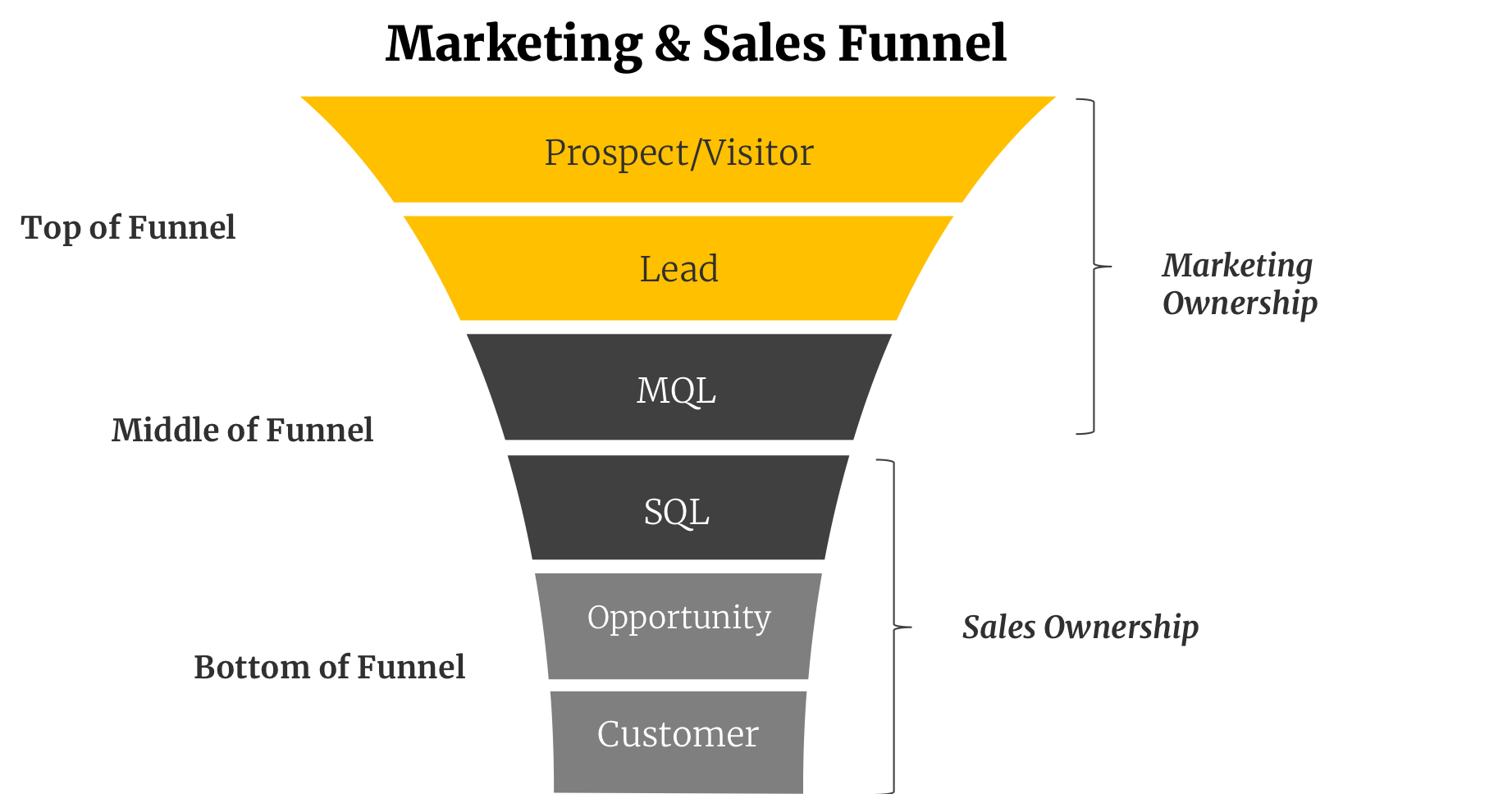How B2B Sales & Marketing Teams Should Work Together

Before we dig into how sales and marketing should work together to improve performance, let’s look at how these two bedfellows came together. Marketing is rooted in advertising. Billboards and direct mail were a vital marketing tactic for years, and they worked, but no one knows exactly how well but it is almost impossible to track the impact.
And sales is a person who reaches out to you out of the blue, who knows nothing about your business needs or what you are interested in but tries to sell you a product. These sales tactics may not lead to an excellent experience for the buyer – but sales always could track every dollar they generate for their company.
However, today’s marketing is different. It should be completely trackable; it should be digital, it should work.
Because marketing has dramatically changed as technology has improved, marketing can now be held accountable for their contributions to revenue – just like sales has always been.
So the gap between marketing and sales has closed. And with the teams working side by side, it is critical they work together. But, can you confidently say you know exactly what is happening with the leads after they are kick over to sales? This is a fundamental question.
More importantly, do both your marketing AND sales teams know the answers to these critical questions?
Do both your marketing and sales teams know what types of collateral a high-value lead is consuming? Are they consuming eBooks, Whitepapers, Lists, Infographics, Webinars? Which ones? What questions on forms are good barometers for your company’s leads? Do both sales and marketing teams know the expectations for lead follow-up by sales?
What are the top reasons a lead does not close? Can both your sales and marketing team list the top 3 reasons?
The chances are high that either your digital marketing agency jobs team or your sales team know the answers to these questions. Very rarely are both sides on the same page. So, this statistic probably comes as no surprise to you:
87% of the terms sales and marketing use to describe each other are negative.
What do marketing and sales say about each other?
Some of the stereotypes marketing use to describe sales include, “Simple minded,” “incompetent,” “lazy”. And for marketing, these stereotypes include “the colouring-in team,” “academic” and “irrelevant”.
JC Penny famously said: “Growth is never by mere chance: It is the result of forces working together.”
Sales and marketing should both be solving problems for the customer and be working together to provide value to your business. But we all know we get bogged down by our day-to-day jobs and don’t have time to remember to loop in other teams.
Sales and marketing teams should be aligning around common goals within your business and maniacally focused on improving revenue growth. Collaboration between the sales and marketing teams boils down to one thing, no matter which way you slice it. Sales and Marketing are two halves of the same team. Team Revenue.
How to better integrate sales and marketing?
How do you do it? How is this possible?? We’ve broken it down into 5 steps:
- Speak the same language.
- Implement a service level agreement.
- Setup closed-loop reporting.
- Rely on data.
- Maintain open communication.
These five step should be leveraged to integrate sales and marketing into your company in order to get your teams working better together and realising that they play for the same team; TEAM REVENUE.
Step 1: Speak the same language
The first step for sales and marketing to start speaking the same language is to define your funnel. Working with key marketing and sales stakeholders, make sure to clearly outline each team’s role in the funnel. In this sample funnel the first two stages are marketing’s responsibility.
The bottom two stages are sale’s responsibility.
The stages in the middle are shared marketing and sales responsibility.
Now it’s time to define the stages, identify what qualifies people for each stage of the funnel and make sure everyone on your sales and marketing teams know this information.

The end results should look something like this. Everyone at your company should know what qualifies a person to be a prospect/visitor, lead, MQL, SQL, opportunity and customer. This is the foundation for all other steps to getting your sales and marketing teams to work together and integrating sales and marketing at your company.

Step 2: Implement a Service Level Agreement
Now you’ve defined ownership, it’s time to implement a service level agreement. A Sales & Marketing SLA defines what each team commits to accomplishing in order to support the other in reaching the shared revenue goal(s). It’s a formal commitment between sales & marketing to meet shared goals for revenue growth.
To be clear its a two way street:
- Marketing– Commits to delivering a certain quantity and quality of leads to help the sales team meet its quota.
- Sales– Commits to follow up on those leads in a timely manner, and to make a specific number of contact attempts before abandoning the lead.
There are a number ways you can think about calculating how many leads a sales rep needs to hit target.

These calculations it will vary depending on what you consider a quality lead. Again, this conversation and exercise should be done as a joint effort between the marketing and sales teams. An SLA is key because it ensures sales and marketing are both working towards the same goal.
Just having the meeting with you sales and marketing team in one room, looking at metrics side by side, is a huge step in the right direction.
An SLA crystallises the alignment around goals. No questions, no second guessing. Once there is an agreement, both teams can work with passion and purpose to meet and surpass well defined goals.
Step 3: Implement a Service Level Agreement
OK, so you now you’ve got your funnel so you’re speaking the same language, and you’ve set your SLA so you are aligned and working towards the same goals. Now it’s time to make sure both teams are staying on track. Closed loop reporting ensures that a proper feedback loop is set up between marketing and sales. Closed loop reporting sets up a way for marketing and sales to talk to one another, while having a positive effect on marketing and sales ROI.
Closed-loop reporting allows Marketing to pass more intel over to sales, and get feedback in return.
Benefits for Marketing of Closed Loop Reporting
- Get up-to-date contact info and status updates
- Learn which marketing programs are working and which aren’t
- Increase Marketing ROI
Benefits for Sales of Closed Loop Reporting
- De-duplicate leads
- Help prioritize leads
- Help make warmer calls
- Increase close rate and Sales ROI
Yes all of those bulleted points under the benefits for sales and marketing are real and can be measured… they are not just pie in the sky ideas that sound too good to be true.
Some of the benefits of closed loop reporting, are:
- Analyse of which marketing sources are producing the most customers
- It allows you to understand how each individual piece of content you create contributes to closing customers
- Provide a timeline of all of the interactions a contact took prior to becoming an MQL or a customer.
Pass information to sales that can help aid them in connecting and engaging with contacts within the first 24 hours and send automatic updates to your sales team when their leads revisit the website or take other key actions, to make sure to follow up at the best time.

Step 4: Rely on Data
Data is the next key to integrating sales and marketing at your company. Dashboards are a great way to consume and share data. You can reference or share them at anytime, with anyone within your company. They can help identify and troubleshoot any issues you may be experiencing. Dashboards also ensure that both teams are looking at the same numbers.
In addition to dashboards, it’s really helpful to do a monthly marketing report. This can be an official document, a PPT deck that is sent over email, or it can take the form of a monthly in person meeting – where marketing and sales BOTH report on their past month’s performance.
This should dig into all the important metrics like your SLA as well as your other funnel metrics. You should evaluate and share why Marketing did or did not hit targets.
Step 5: Maintain Open Communication
And the final step. Maintain Open Communication. Besides sharing your stats in a monthly meeting for your sales and marketing teams – leaders in both your sales and marketing teams should come together for an in-person meeting to get on the same page about team successes, product information, persona education and SLA waterfalls.
This is a time where you can look at your shared dashboard and address any concerning trends – this opens the conversation up everything from lead flow and quality, to hiring plans for your sales team.
Meetings should cover major communication on a monthly basis. This is great, but it doesn’t solve for the day to day. Marketers should Market your company’s campaigns to your sales team in emails and easy to digest formats as well.
And whether you sell a physical product or a service – things are always changing!
Because marketing needs to create collateral (web pages, data sheets and so on) about updates to products and services, they’re in the know before sales – Marketing should take the responsibility to train and arm the sales team with the details of these changes, and the positioning for why customers/prospects will care.
Summary
These 5 steps will help bring a successful sales and marketing practice into your organization.
- Speak the same language.
- Implement a Service Level Agreement
- Setup closed-loop reporting.
- Rely on data.
- Maintain open communication.
One of the most important things to keep in mind when integrating a sales and marketing practice to your company is to relay on data, not emotions. You need to separate reality from perception. Finger pointing and failure to collaborate will result in a sinking ship. But following the 5 steps will ensure you set up a strong and successful sales and marketing practice within your organization and that sales and marketing will live in a productive harmony.
Reach Your Revenue Goals. Grow MRR with Gripped.
Discover how Gripped can help drive more trial sign-ups, secure quality demos with decision makers and maximise your marketing budget.
Here's what you'll get:
- Helpful advice and guidance
- No sales pitches or nonsense
- No obligations or commitments



Book your free digital marketing review
Other Articles you maybe interested in
What B2B SaaS Founders Want from their CMOs – Thoughts and Analysis 2025
B2B SaaS founders are typically driven by product innovation and business growth. They launch companies to solve pressing customer problems and capture new markets, which makes achieving product-market fit and scaling revenue top priorities. In founder surveys, hiring the right team consistently ranks as a major concern – for example, First Round Capital found that…
The 100 Best SaaS Websites Examples to Get Inspiration (Updated for 2025)
It’s undeniable that a well-executed website is a deal breaker for a customer looking to invest in a B2B SaaS brand. Getting the balance between eye-catching content and practicality is no small feat, but it will make all the difference in attracting potential customers — something the best SaaS websites on this list have nailed. …
A Practical Guide to CAC and LTV for B2B SaaS Marketers
For B2B marketers understanding key metrics like Customer Acquisition Cost (CAC), CAC Payback Period, Customer Lifetime Value (LTV), and the LTV:CAC ratio is crucial for planning, managing and executing in way that delivers sustainable growth. These metrics reveal how much it costs to earn a customer, how valuable that customer is over time and how…


